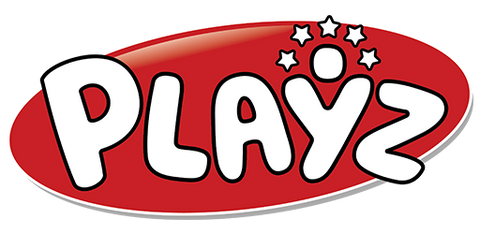
The Ultimate Guide to Educational Toys for Kindergarten
When it comes to the best educational toys for kindergarten, think of them less as simple playthings and more as the essential tools that kickstart a child's love for learning. The right toy sparks curiosity, builds genuine problem-solving skills, and sets the foundation for a lifetime of discovery—all through the simple act of having fun.
Why Play Is the Most Powerful Learning Tool
For a kindergartener, playtime isn't just a way to pass the hours; it's how their brain is built. This is the time they wire neural connections, test theories about the world, and learn to navigate social landscapes. This concept, known as play-based learning, redefines toys as critical instruments for development, not just fun distractions.
The best educational toys are catalysts for learning. They don't just entertain; they invite a child to explore, ask questions, and create. This hands-on engagement is absolutely essential for building the core skills that passive learning, like sitting behind a desk, simply can't teach.
Laying the Foundation for Future Skills
Every time a child stacks a block or negotiates the rules of a pretend game, they're laying another brick in their developmental foundation. These seemingly small moments are packed with learning opportunities that shape everything from their cognitive abilities to their social interactions.
- Problem-Solving in Action: When a child figures out how to keep a tower of blocks from toppling, they're getting a hands-on lesson in physics, gravity, and spatial awareness—no textbook required. This is a real-world example of trial and error leading to a concrete solution.
- Social and Emotional Growth: A game of make-believe with action figures isn't just fun; it's a complex negotiation of empathy, teamwork, and seeing things from another's point of view. They learn to share, take turns, and resolve conflicts.
- Building Resilience: Trying to fit a puzzle piece, failing, and trying again teaches persistence. It builds a healthy response to frustration, a skill that's absolutely crucial for success in school and in life.
Play is the highest form of research. It’s a safe space where kids can experiment with ideas, take risks, and discover outcomes on their own terms. That's the heart of real, lasting learning.
The Growing Recognition of Purposeful Play
Parents and educators are increasingly recognizing the incredible power of purposeful play. This isn't just a trend; it's backed by data. The global educational toys market was valued at USD 54 billion in 2023 and is expected to more than double by 2030. According to Grand View Research, this boom reflects a clear global consensus: we need to invest in toys that build real developmental skills right from the start.
To help you get a quick overview, here’s a breakdown of how different toys target key developmental areas.
Key Developmental Areas Targeted by Educational Toys
This table summarizes the core skills that educational toys help build, connecting each developmental area with a specific type of toy.
| Developmental Area | Skills Developed | Practical Toy Examples |
|---|---|---|
| Cognitive | Problem-solving, critical thinking, memory, spatial reasoning | Puzzles, Building Blocks, Coding Robots |
| Social & Emotional | Empathy, sharing, communication, conflict resolution | Pretend Play Sets, Dolls, Cooperative Board Games |
| Fine Motor | Hand-eye coordination, dexterity, pincer grasp | Art Supplies, Lacing Beads, Play-Doh |
| Gross Motor | Balance, coordination, physical strength | Tricycles, Balls, Climbing Structures |
| Language & Literacy | Vocabulary, storytelling, letter recognition | Alphabet Blocks, Picture Books, Puppets |
As you can see, each category of toy offers a unique pathway for growth, making a well-rounded toy collection a powerful tool for a kindergartener's development.
This approach aligns perfectly with a powerful educational philosophy we explore in our guide to what is discovery-based learning, where kids are empowered to lead their own journey of understanding. When you choose educational toys for your kindergartener with intention, you're not just buying another thing to clutter the playroom. You're curating an environment for growth and setting the stage for a curious, confident, and capable learner.
Exploring the Best Types of Learning Toys
Walking into a toy store can feel overwhelming. It’s a jungle of bright colors and endless choices, all screaming for your attention. So, how do you find the hidden gems—the toys that actually spark real learning and lasting joy?
The trick is to think in categories. Don't just see a wall of toys; see the different skills each one is designed to build. Think of it like putting together a balanced meal for your kindergartener’s growing mind. You need a mix of different "food groups"—some for logic, some for creativity, and others for physical and emotional growth. We've broken down the best educational toys into five key groups that work together to support a well-rounded kid.
This infographic breaks down how these different toy categories feed into the three main areas of a child's development.
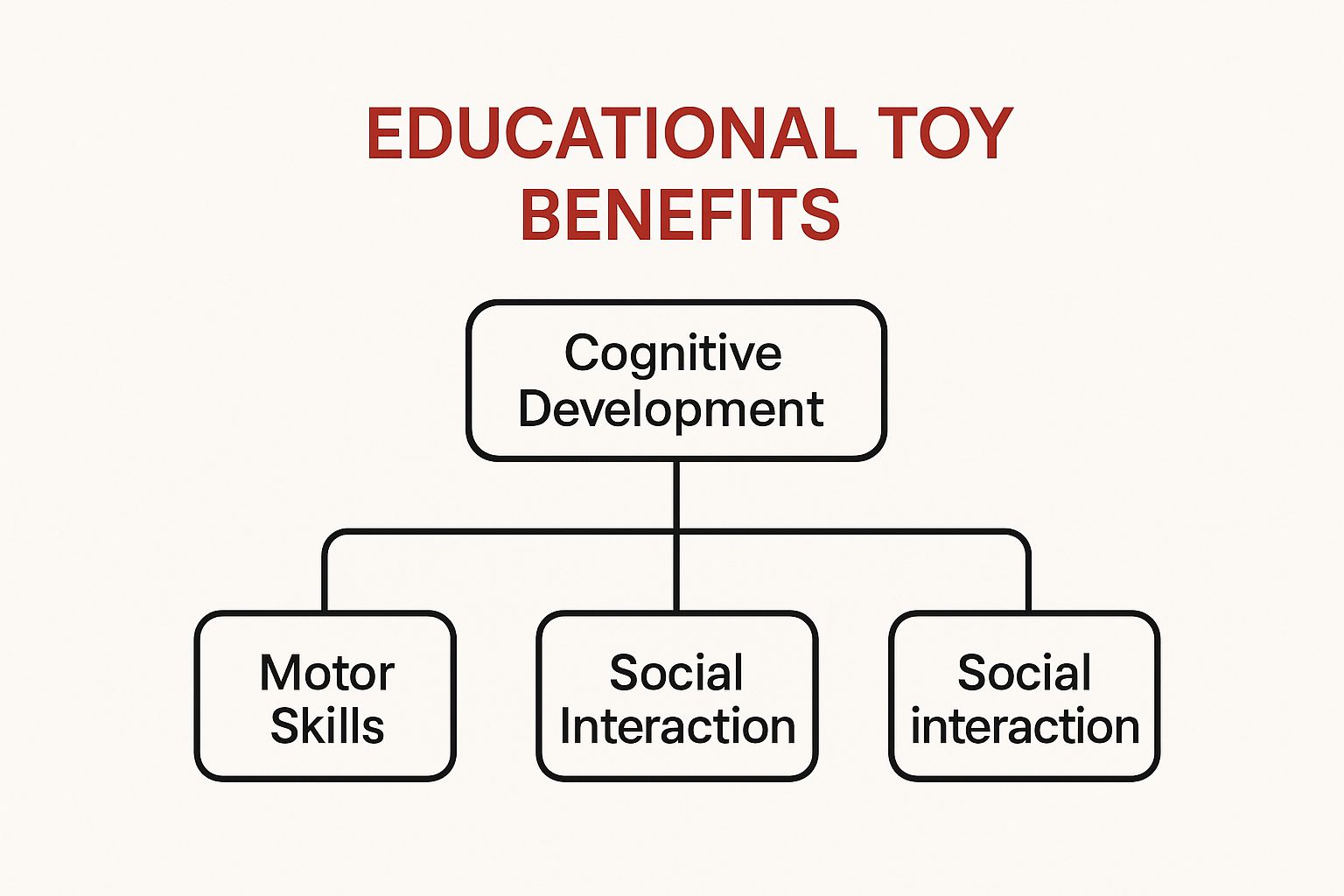
As you can see, cognitive skills, motor abilities, and social smarts are the pillars of early learning. The right toys are tools designed to strengthen each one.
STEM Toys for Kindergarten Innovators
STEM (Science, Technology, Engineering, and Math) might sound complex for a five-year-old, but the toys in this category are all about tapping into their natural curiosity. These are the ultimate "how does it work?" toys that encourage experimentation.
Even simple building blocks are a child's first lesson in engineering. They're experimenting with balance, gravity, and structural integrity every time they build a tower—and gleefully watch it tumble. Magnetic tiles and interlocking bricks take this a step further, teaching geometry and spatial reasoning in a totally hands-on way.
- Building Blocks: Teach the basics of physics and problem-solving.
- Simple Science Kits: Introduce cause-and-effect with fun, safe experiments (like a classic baking soda volcano).
- Beginner Coding Toys: Use screen-free robots to teach the fundamentals of sequencing and logic.
These toys don't just teach facts; they build a mindset of experimentation and critical thinking. If you want to dive deeper, you can check out our comprehensive guide to STEM toys for kids.
Literacy and Language Toys That Build Future Readers
A solid foundation in language is one of the most powerful gifts you can give a kindergartener. Toys in this category turn learning letters, sounds, and stories into a game instead of a chore.
Alphabet puzzles are a classic for a reason. They help kids connect the shape of a letter with its sound through tactile feedback. Storytelling cards or puppets are fantastic for encouraging kids to create their own narratives, which boosts vocabulary, sentence structure, and imagination all at once.
These toys transform abstract symbols—like the letter 'A'—into something tangible and playful. This connection is what builds the bridge between seeing a letter and understanding it's a key to unlocking a world of stories.
Arts and Crafts for Creative Expression and Fine Motor Skills
Creativity isn't just about making pretty pictures. It’s about developing flexible thinking and finding new ways to solve problems. Arts and crafts supplies also happen to be one of the best ways to develop the fine motor skills kids need for writing.
Working with modeling clay, for example, strengthens the tiny muscles in their hands and fingers—the same ones they'll use to hold a pencil. Painting at an easel encourages bigger arm movements and improves hand-eye coordination. Even a simple box of crayons gives a child a powerful tool to bring their thoughts and feelings to life.
Motor Skill Development Toys for Active Bodies
Kindergarten is a time of huge physical growth, and toys that get kids moving are non-negotiable. These generally fall into two key groups that work hand-in-hand.
- Gross Motor Toys: These are all about the big muscle groups. Think tricycles, balls, and small climbing structures that build coordination, balance, and physical confidence.
- Fine Motor Toys: These focus on the small, precise movements of the hands and fingers. Lacing beads, puzzles with chunky knobs, and scissor skills kits are perfect examples that build dexterity for tasks like buttoning a coat or writing their name.
Social-Emotional Learning Games for Building Empathy
Learning how to get along with others is arguably the most important lesson of kindergarten. Toys designed for social-emotional learning (SEL) help children understand their own feelings and learn to recognize them in others.
Cooperative board games are amazing for this. They teach turn-taking, patience, and how to handle winning and losing with grace. Pretend play sets, like a doctor's kit or a play kitchen, let children role-play different social situations, building empathy and communication skills as they go. Even toys like the "Big Feelings Pineapple" give kids a vocabulary for their emotions, which is the first step toward managing them.
Unpacking the Developmental Benefits of Play
Now that we have a map of the different toy categories, let's zoom in on the incredible developmental work happening behind the scenes. When a kindergartener is lost in play, their brain is firing on all cylinders. It’s not just fun and games; every choice, every action, and every pretend scenario is a powerful learning moment that builds the foundation for their future academic and social success.
Play isn’t just something kids do. It's how they're wired to learn.
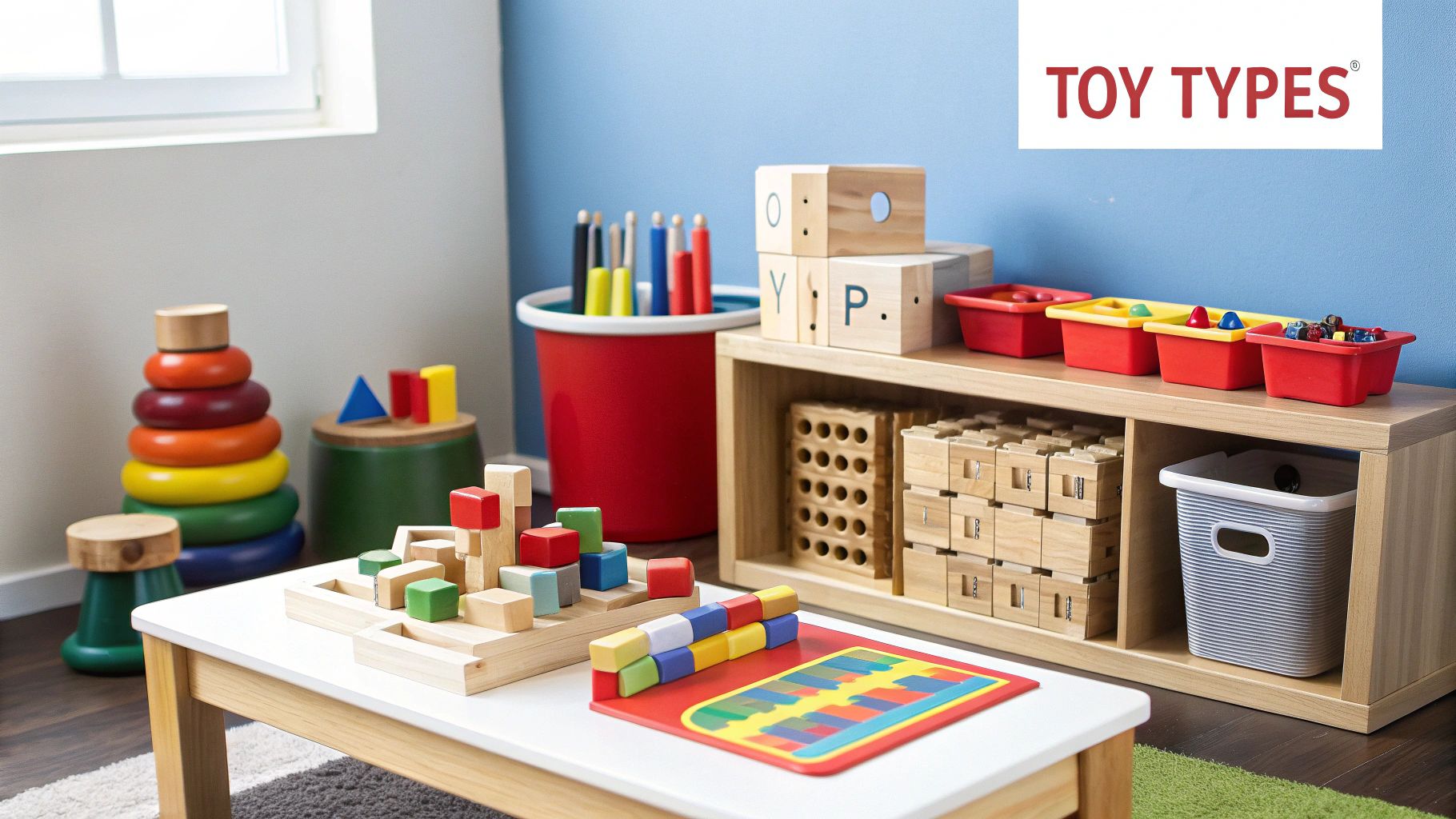
Think of it like this: a toy is a key, and a child’s mind is a lock full of unopened doors. The right toy doesn't just open one door; it unlocks whole new sets of skills. This is where educational toys for kindergarten truly shine, turning simple playtime into a powerhouse for cognitive, social, and emotional growth.
Cognitive Leaps Through Hands-On Problem Solving
Cognitive development is all about how kids think, explore, and figure things out. Toys are the perfect tools for this because they make abstract concepts totally tangible. They give kids a chance to physically get their hands on a problem and literally move the pieces around until they find a solution.
Take a simple jigsaw puzzle. As a child turns a piece, trying to feel out its correct spot, they’re actively strengthening their spatial reasoning and visual discrimination. This isn't just about matching shapes; it’s about training their brain to see patterns and understand how individual parts form a whole—a skill that’s absolutely essential for both math and reading down the road.
Play creates a safe space to fail. When a block tower tumbles or a puzzle piece refuses to fit, a child learns resilience. They learn to figure out what went wrong and try a new approach, building a flexible, problem-solving mindset from the ground up.
This process of trial and error is where the deepest learning happens. For more ideas on nurturing this skill, you can check out our guide on how to develop problem-solving skills in children. It really dives into how these playful experiments lay the groundwork for more complex thinking later on.
Fostering Social and Emotional Intelligence
Some of the most critical life lessons don't come from a worksheet—they're learned by interacting with others. This is where social-emotional learning (SEL) toys come into play. They create tiny social laboratories where kids can safely practice essential people skills.
A cooperative board game, for instance, is a masterclass in emotional regulation. A child learns to:
- Practice patience while waiting for their turn.
- Manage disappointment when they land on a "go back three spaces" square.
- Navigate friendly competition and learn to be happy for a friend's win.
Likewise, pretend play sets—like a play kitchen or a veterinarian clinic—are invaluable. When children take on roles and act out different scenarios, they’re practicing empathy, negotiation, and communication. They learn to see the world from someone else’s perspective, which is the very heart of emotional intelligence. Research shows that kids with strong social-emotional skills aren't just happier; they also do better in school.
Building Focus and Fine Motor Precision
In a world overflowing with distractions, the ability to concentrate is a superpower. Many educational toys are brilliant at helping kids build that focus muscle. The intricate task of threading beads onto a string or carefully balancing one magnetic tile on top of another requires sustained attention and precision.
This kind of focused play also develops fine motor skills, strengthening all the small muscles in the hands and fingers. These are the very same muscles they’ll need for holding a pencil, using scissors, and buttoning a coat.
Actionable Examples of Skill-Building Play:
- Activity: Using modeling clay to create small figures.
- Benefit: Enhances hand strength, dexterity, and lets their creative side run wild.
- Activity: Assembling a simple construction set with nuts and bolts.
- Benefit: Improves hand-eye coordination and builds concentration.
When you connect these simple activities to huge developmental milestones, it’s clear that educational toys are so much more than entertainment. They are thoughtfully designed tools that empower our kids to build the skills they need to thrive, both in kindergarten and far beyond.
How to Choose the Right Educational Toys
Stepping into a toy store can feel overwhelming, but picking the perfect educational toy doesn't have to be. The real goal is to find something that grabs your kindergartener's attention while secretly slipping in a bunch of developmental benefits. A truly great toy should feel like an invitation to play, not a homework assignment.
Think of yourself as a play detective. Your job is to spot the clues that tell you what will really click with your kid. If you focus on a few key things—like age-appropriateness, safety, and whether a toy can be played with over and over—you can pick a winner every time.
Tip 1: Start with Age Appropriateness and Safety
The age range on the box is a great starting point, but you know your child best. A toy labeled for a 4-year-old might still be perfect for your 5-year-old if they're working on that specific skill. On the flip side, they might be ready for something more advanced.
The secret is finding that "just-right" challenge. The toy needs to be tough enough to stay interesting but not so hard it ends in a frustrated tantrum. That sweet spot is where real learning happens—it’s where they feel that awesome sense of accomplishment.
Of course, safety is always the top priority. No exceptions. Make sure any toy you buy is:
- Made from non-toxic materials: Check that all paints and plastics are certified as safe for kids.
- Free of small parts: This is especially important for younger kindergarteners, as anything small can be a choking hazard.
- Sturdy and well-constructed: The toy needs to hold up to some serious, enthusiastic play without breaking into sharp pieces.
Tip 2: Prioritize Open-Ended Toys for Lasting Value
Some toys are one-trick ponies. They do one thing, and once your kid figures it out, the novelty is gone. But open-ended toys? They're the superstars of the playroom because they can be used in a million different ways.
An open-ended toy doesn't tell a child what to do; it asks them, "What can you create?" This simple shift is the difference between passive entertainment and active, imaginative learning.
Think about a simple set of wooden blocks versus an electronic toy that sings the ABCs when you press a button. The electronic toy has one job. But those blocks? They can be a castle, a spaceship, a bridge, or a whole city for their action figures. They teach physics, problem-solving, and creativity, and they grow right along with your child's imagination.
This kind of thoughtful play is getting more attention than ever. The market for learning and education toys was valued at USD 61.94 billion in 2025 and is projected to skyrocket to USD 82.4 billion by 2029. This boom is all about the global focus on STEM and toys that offer this exact kind of flexible, open-ended experience.
Tip 3: Align Toys with Your Child's Interests
Let's be real: the most educational toy on the planet is useless if your kid won't touch it. The secret ingredient is making it relevant to them. Pay attention to what your kindergartener is naturally obsessed with right now.
Do they love dinosaurs? A dino-themed puzzle or a fossil digging kit will feel like the best gift ever, not a lesson. Are they always trying to "help" in the kitchen? A play kitchen or pretend food can teach counting, sorting, and social skills through make-believe. When you tap into their passions, you guarantee the toy will get picked up again and again. For more ideas that hit the mark, check out this fantastic collection of educational toys for 5 to 7-year-olds.
Quick Toy Selection Checklist for Parents
Before you head to the checkout, it helps to have a quick checklist in mind. This simple guide can help you look past the flashy packaging and see if a toy is truly a good investment for your child's playroom.
| Selection Criterion | What to Look For | Why It Matters |
|---|---|---|
| Play Value | Can this toy be used in multiple ways? Does it spark imagination? | Open-ended toys grow with your child and offer far more learning opportunities than single-purpose toys. |
| Skill Building | What specific skill does this toy target (e.g., motor, cognitive, social)? | Ensures the toy is contributing to a specific area of your child's development. |
| Engagement Factor | Does it connect to my child's current interests and passions? | A toy that aligns with their interests will be used more often and for longer periods. |
| Durability | Is it made from high-quality materials that can withstand rough play? | A well-made toy is safer and provides better long-term value, avoiding the frustration of it breaking easily. |
Using this simple framework will help you make confident choices. You'll be picking toys that don't just entertain but also build a solid foundation for a lifelong love of learning, one playful moment at a time.
Bringing Purposeful Play into Your Daily Routine
Having a shelf full of fantastic educational toys for kindergarten is a great first step. But the real magic happens when you weave that purposeful play right into your daily rhythm. It’s not about carving out a strict “learning time” slot in your schedule. It's about creating an environment where curiosity is the default setting.
When you do this, ordinary moments become chances to grow, and learning starts to feel less like a chore and more like a fun, natural habit. The idea is to make play part of the fabric of your day, showing your child that learning is happening all the time, not just with certain toys at certain times.
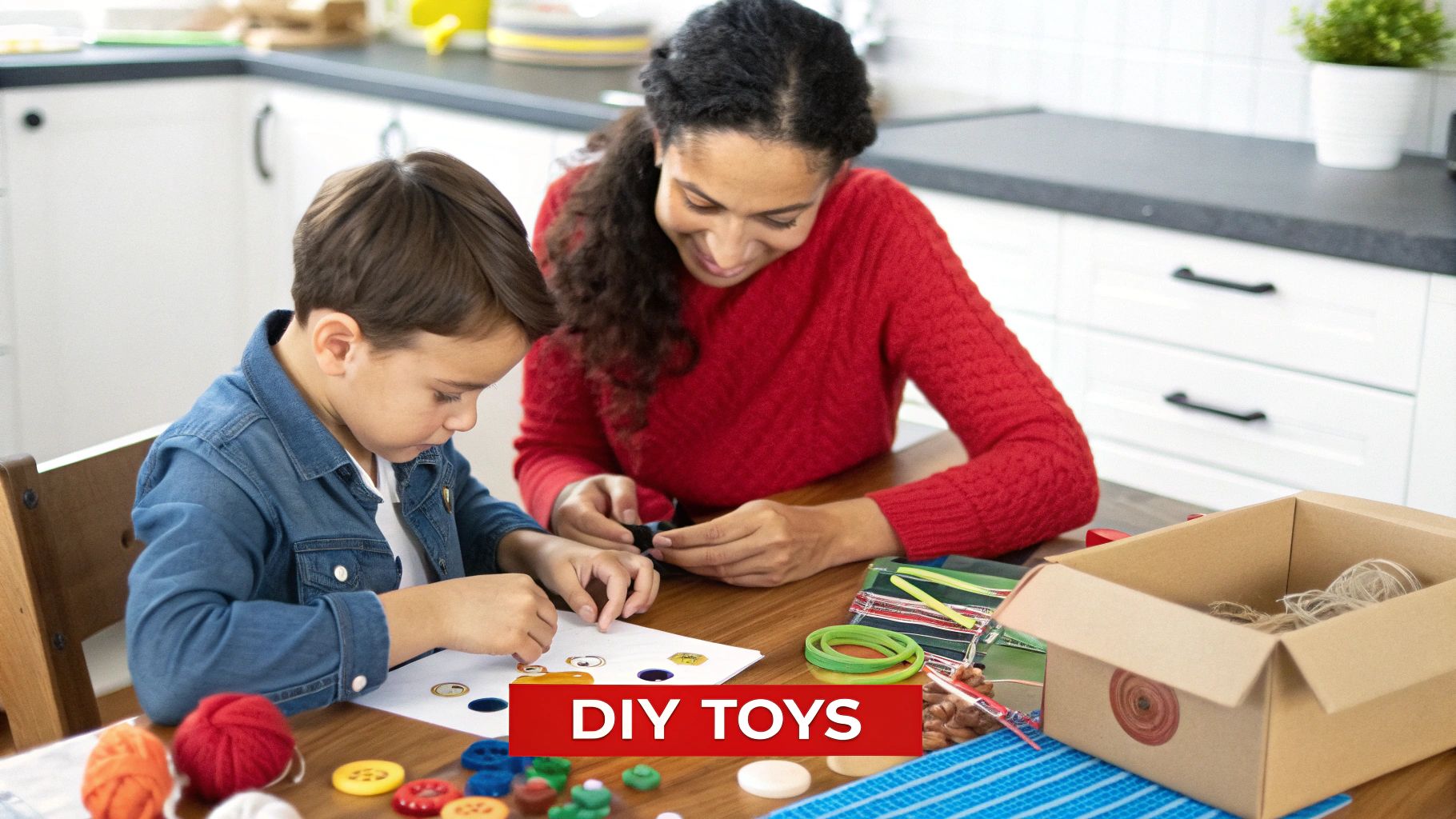
Actionable Strategy 1: Create an Inviting and Accessible Play Area
A child’s play space should feel like a personal invitation to explore. A well-organized, accessible area empowers them to follow their own interests and take charge of their playtime. You don't need a massive playroom; even a dedicated corner can become a powerful learning hub.
Here are a few simple tips for getting the space just right:
- Use Low, Open Shelving: Put toys on shelves where your child can actually see and reach them. This does wonders for their independence. They can pick out what they want to play with and—just as crucial—learn to put things back on their own.
- Keep It Tidy and Uncluttered: Ever seen a kid get overwhelmed by too many options? A clean, organized space helps them focus on one thing at a time, which leads to deeper, more meaningful play.
- Designate Zones for Different Activities: Try setting up a cozy nook with pillows for reading, a small table for puzzles and art, and some open floor space for block-building. This simple structure helps kids understand that different activities have their own special place.
Actionable Strategy 2: Use the Power of Toy Rotation
You know how a toy that's been ignored for months suddenly becomes the most fascinating thing in the house when you pull it out of a closet? That's the secret behind toy rotation.
By cycling a few toys in and out of the play area every couple of weeks, you keep their environment feeling fresh and exciting. It’s a simple trick that prevents "play blindness"—that thing that happens when kids get so used to seeing the same stuff that they stop really seeing it at all. A smaller, curated selection encourages them to get more creative with what they have.
Toy rotation isn't about hiding toys away. It's about reintroducing them. That hit of novelty is often all it takes to reignite a child’s curiosity and challenge them to find new ways to play with old favorites.
Actionable Strategy 3: Be an Engaged Play Partner
Your involvement is one of the most powerful tools you have. Being a play partner doesn't mean you need to direct the show or take over. It’s more about being a co-conspirator in their discovery, showing genuine curiosity, and asking questions that get their gears turning.
Instead of telling them what to build, try asking open-ended questions that nudge their problem-solving skills along:
- "Hmm, I wonder what would happen if we put that really big block on the bottom?"
- "Wow, what a tall tower! How could we make it even stronger so it doesn't wobble?"
- "Can you tell me the story of what your little figures are up to?"
These kinds of questions guide their thinking without just handing them the answers. It encourages them to think critically, express their ideas, and shows them that what they're doing is important.
For more ideas on how to jump in, check out our guide to hands-on learning activities. By blending these strategies together, you’ll make learning a seamless and genuinely joyful part of everyday life.
Your Role in Building a Lifelong Love for Learning
Picking out the right educational toys is a great way to support your kindergartener's development, but those toys are only half the story. The most important piece of the puzzle isn't a toy at all—it's you. When you get involved, you transform a simple activity into a memorable lesson in creativity, problem-solving, and confidence.
Think about it. When you get down on the floor to build a wobbly block tower or ask silly questions during a make-believe tea party, you're not just playing. You're showing your child that learning is a fun, shared adventure, not a chore they have to do alone. This is the secret sauce that unlocks what any educational toy can truly offer.
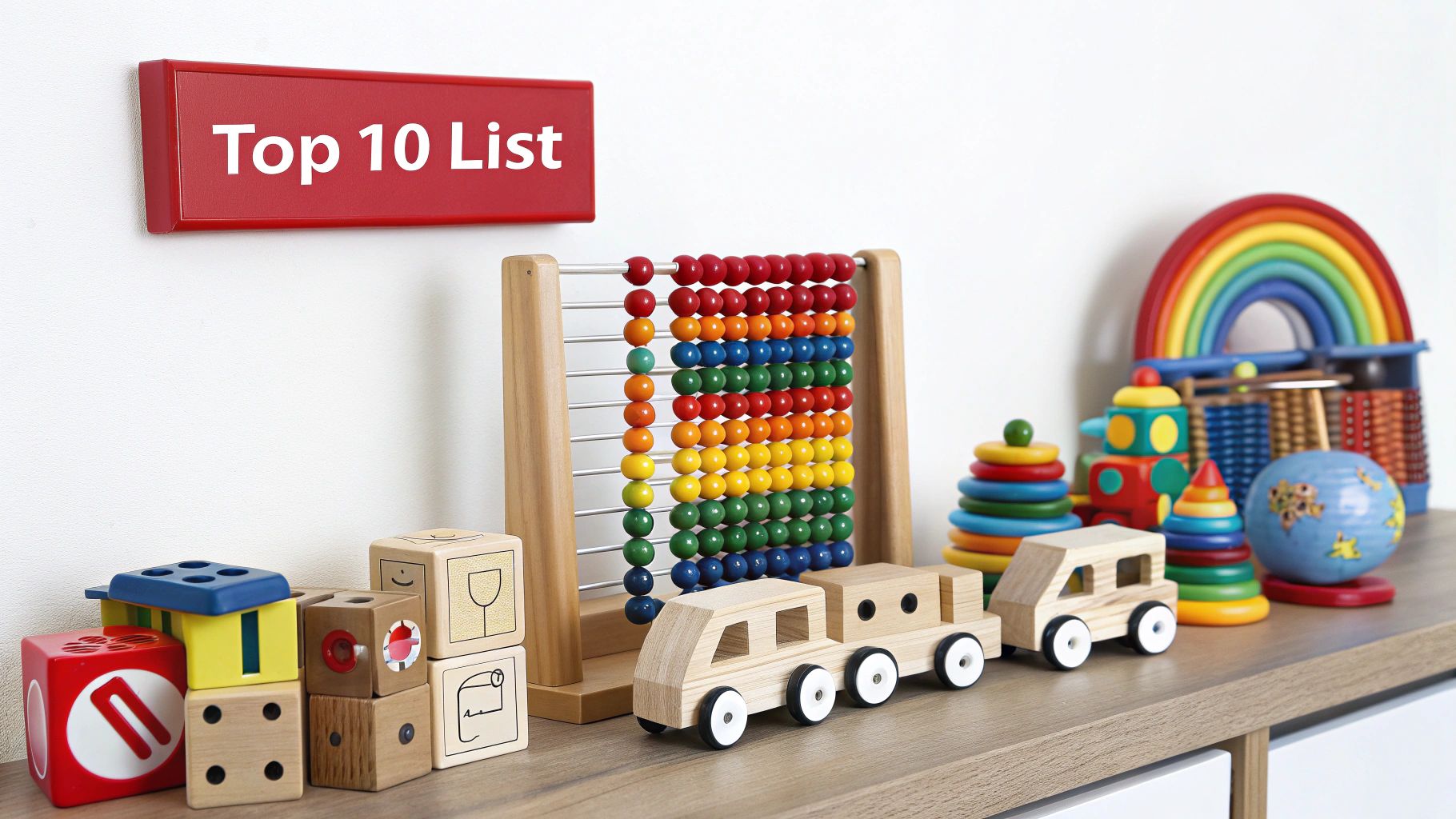
When you thoughtfully choose toys and jump into your child’s world of play, you’re doing so much more than just getting them ready for school. You're investing in their future curiosity and planting the seeds for a genuine, lifelong love of learning.
Your job is to be a guide, a cheerleader, and a co-explorer. Celebrate their small wins, encourage them when things get tricky, and share in their excitement. That connection is what really makes the lessons stick, building a foundation for a curious and passionate mind for years to come.
Frequently Asked Questions About Educational Toys
Navigating the world of educational toys can bring up a lot of questions. From screen time debates to budget concerns, parents and educators want to make the best choices for their kids. Here are clear, practical answers to some of the most common questions we hear.
How do I balance digital toys with traditional toys?
Finding the right balance is key. Digital educational apps can be fantastic for teaching specific skills like phonics or basic coding in an engaging way. However, they can't replace the rich, sensory experience of hands-on play.
Pros & Cons: Digital vs. Traditional Toys
| Toy Type | Pros | Cons |
|---|---|---|
| Digital Toys | Highly engaging, excellent for specific skill drills (like math facts). | Can be passive, lacks tactile feedback, risk of too much screen time. |
| Traditional Toys | Builds fine/gross motor skills, fosters creativity, encourages social interaction. | Can be less initially engaging for some kids used to screens. |
Actionable Tip: For every 30 minutes of educational screen time, aim for at least an hour of active, screen-free play. And when they do use a digital toy, engage with them. Ask questions about what they're learning to connect their digital experience back to the real world.
Are expensive educational toys always better?
Absolutely not. A toy’s real value lies in its ability to spark curiosity and engage a child’s mind—and that has nothing to do with the price tag. In fact, many of the most powerful educational toys for kindergarten are timeless, affordable classics.
Consider these budget-friendly powerhouses:
- Building blocks: A secret lesson in physics, balance, and problem-solving.
- Play-Doh: Fantastic for strengthening hand muscles needed for writing while fostering creativity.
- Crayons and paper: The ultimate tools for self-expression and developing fine motor control.
Often, an open-ended toy that can be used in countless ways offers far more long-term value than a flashy electronic gadget that only does one thing. Always prioritize play potential over price.
How can I introduce STEM toys without causing frustration?
The key to introducing new STEM toys is to keep it low-pressure and fun. Frame it as playtime, not a "lesson." The best way to get kids excited about science and tech is with toys that are intuitive, hands-on, and lead to a fun "Aha!" moment.
You're probably already doing it! Using building blocks to see how high you can stack them before they fall? That's engineering. Playing with cups in the bathtub to see which holds more water? That's a lesson on volume. A simple magnifying glass can turn a walk around the block into a scientific expedition.
The goal is to connect these big ideas to things they can touch and see, firing up their natural curiosity. To avoid frustration, stick to beginner science kits or coding toys made specifically for the 4-6 age group.
At Playz, we believe learning should feel like an adventure. Our science kits and creative toys are designed to spark curiosity, making big ideas fun and accessible for young minds. Explore our collections today and find the perfect tool to ignite a lifelong passion for discovery.
